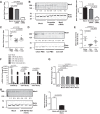Intestinal bile acid sequestration improves glucose control by stimulating hepatic miR-182-5p in type 2 diabetes
- PMID: 30160993
- PMCID: PMC6415711
- DOI: 10.1152/ajpgi.00238.2018
Intestinal bile acid sequestration improves glucose control by stimulating hepatic miR-182-5p in type 2 diabetes
Abstract
Colesevelam is a bile acid sequestrant approved to treat both hyperlipidemia and type 2 diabetes, but the mechanism for its glucose-lowering effects is not fully understood. The aim of this study was to investigate the role of hepatic microRNAs (miRNAs) as regulators of metabolic disease and to investigate the link between the cholesterol and glucose-lowering effects of colesevelam. To quantify the impact of colesevelam treatment in rodent models of diabetes, metabolic studies were performed in Zucker diabetic fatty (ZDF) rats and db/db mice. Colesevelam treatments significantly decreased plasma glucose levels and increased glycolysis in the absence of changes to insulin levels in ZDF rats and db/db mice. High-throughput sequencing and real-time PCR were used to quantify hepatic miRNA and mRNA changes, and the cholesterol-sensitive miR-96/182/183 cluster was found to be significantly increased in livers from ZDF rats treated with colesevelam compared with vehicle controls. Inhibition of miR-182 in vivo attenuated colesevelam-mediated improvements to glycemic control in db/db mice. Hepatic expression of mediator complex subunit 1 (MED1), a nuclear receptor coactivator, was significantly decreased with colesevelam treatments in db/db mice, and MED1 was experimentally validated to be a direct target of miR-96/182/183 in humans and mice. In summary, these results support that colesevelam likely improves glycemic control through hepatic miR-182-5p, a mechanism that directly links cholesterol and glucose metabolism. NEW & NOTEWORTHY Colesevelam lowers systemic glucose levels in Zucker diabetic fatty rats and db/db mice and increases hepatic levels of the sterol response element binding protein 2-responsive microRNA cluster miR-96/182/183. Inhibition of miR-182 in vivo reverses the glucose-lowering effects of colesevelam in db/db mice. Mediator complex subunit 1 (MED1) is a novel, direct target of the miR-96/182/183 cluster in mice and humans.
Keywords: bile acid sequestrants; cholesterol; glucose metabolism; microRNAs; sterol-regulatory element binding protein 2.
Conflict of interest statement
No conflicts of interest, financial or otherwise, are declared by the authors.
Figures







Similar articles
-
Effect of bile acid sequestrants on glucose metabolism, hepatic de novo lipogenesis, and cholesterol and bile acid kinetics in type 2 diabetes: a randomised controlled study.Diabetologia. 2012 Feb;55(2):432-42. doi: 10.1007/s00125-011-2382-3. Epub 2011 Dec 2. Diabetologia. 2012. PMID: 22134839 Clinical Trial.
-
The combination of colesevelam with sitagliptin enhances glycemic control in diabetic ZDF rat model.Am J Physiol Gastrointest Liver Physiol. 2012 Apr 15;302(8):G815-23. doi: 10.1152/ajpgi.00295.2011. Epub 2012 Jan 26. Am J Physiol Gastrointest Liver Physiol. 2012. PMID: 22281473
-
Potential New Approaches to Modifying Intestinal GLP-1 Secretion in Patients with Type 2 Diabetes Mellitus : Focus on Bile Acid Sequestrants.Clin Drug Investig. 2012 Jan;32(1):1-14. doi: 10.2165/11595370-000000000-00000. Clin Drug Investig. 2012. PMID: 27933595 Review.
-
Bile salt sequestration induces hepatic de novo lipogenesis through farnesoid X receptor- and liver X receptor alpha-controlled metabolic pathways in mice.Hepatology. 2010 Mar;51(3):806-16. doi: 10.1002/hep.23408. Hepatology. 2010. PMID: 19998408
-
A review of bile acid sequestrants: potential mechanism(s) for glucose-lowering effects in type 2 diabetes mellitus.Postgrad Med. 2009 May;121(3 Suppl 1):25-30. doi: 10.3810/pgm.2009.05.suppl53.290. Postgrad Med. 2009. PMID: 19494475 Review.
Cited by
-
The Role of MicroRNAs in Hyperlipidemia: From Pathogenesis to Therapeutical Application.Mediators Inflamm. 2022 Jun 17;2022:3101900. doi: 10.1155/2022/3101900. eCollection 2022. Mediators Inflamm. 2022. PMID: 35757107 Free PMC article. Review.
-
Colesevelam-induced hypoglycaemia in a patient with type 1 diabetes mellitus.Clin Case Rep. 2021 Oct 15;9(10):e04830. doi: 10.1002/ccr3.4830. eCollection 2021 Oct. Clin Case Rep. 2021. PMID: 34691455 Free PMC article.
-
A novel role for farnesoid X receptor in the bile acid-mediated intestinal glucose homeostasis.J Cell Mol Med. 2020 Nov;24(21):12848-12861. doi: 10.1111/jcmm.15881. Epub 2020 Oct 8. J Cell Mol Med. 2020. PMID: 33029898 Free PMC article.
-
Bile acids and microbes in metabolic disease.World J Gastroenterol. 2022 Dec 28;28(48):6846-6866. doi: 10.3748/wjg.v28.i48.6846. World J Gastroenterol. 2022. PMID: 36632317 Free PMC article. Review.
-
Integrated Analyses Identify Key Molecules and Reveal the Potential Mechanism of miR-182-5p/FOXO1 Axis in Alcoholic Liver Disease.Front Med (Lausanne). 2021 Dec 7;8:767584. doi: 10.3389/fmed.2021.767584. eCollection 2021. Front Med (Lausanne). 2021. PMID: 34950682 Free PMC article.
References
-
- Allen RM, Zhao S, Ramirez Solano MA, Zhu W, Michell DL, Wang Y, Shyr Y, Sethupathy P, Linton MF, Graf GA, Sheng Q, Vickers KC. Bioinformatic analysis of endogenous and exogenous small RNAs on lipoproteins. J Extracell Vesicles 7: 1506198, 2018. doi:10.1080/20013078.2018.1506198. - DOI - PMC - PubMed
Publication types
MeSH terms
Substances
Grants and funding
LinkOut - more resources
Full Text Sources
Other Literature Sources
Medical
Molecular Biology Databases
Miscellaneous

